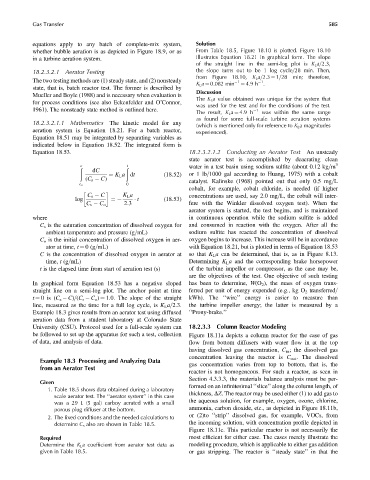Page 630 - Fundamentals of Water Treatment Unit Processes : Physical, Chemical, and Biological
P. 630
Gas Transfer 585
equations apply to any batch of complete-mix system, Solution
whether bubble aeration is as depicted in Figure 18.9, or as From Table 18.5, Figure 18.10 is plotted. Figure 18.10
in a turbine aeration system. illustrates Equation 18.21 in graphical form. The slope
of the straight line in the semi-log plot is K L a=2.3,
18.2.3.2.1 Aerator Testing the slope turns out to be 1 log cycle=28 min. Then,
from Figure 18.10, K L a=2.3 ¼ 1=28 min; therefore,
The two testing methods are (1) steady state, and (2) nonsteady 1 1
K L a ¼ 0.082 min ¼ 4.9 h .
state, that is, batch reactor test. The former is described by
Discussion
Mueller and Boyle (1988) and is necessary when evaluation is
The K L a value obtained was unique for the system that
for process conditions (see also Eckenfelder and O’Connor,
was used for the test and for the conditions of the test.
1961). The nonsteady state method is outlined here. 1
The result, K L a ¼ 4.9 h was within the same range
as found for some full-scale turbine aeration systems
18.2.3.2.1.1 Mathematics The kinetic model for any
(which is mentioned only for reference to K L a magnitudes
aeration system is Equation 18.21. For a batch reactor, experienced).
Equation 18.51 may be integrated by separating variables as
indicated below in Equation 18.52. The integrated form is
Equation 18.53. 18.2.3.2.1.2 Conducting an Aerator Test An unsteady
state aerator test is accomplished by deaerating clean
ð c ð t water in a test basin using sodium sulfite (about 0.12 kg=m 3
dC
¼ K L a dt (18:52) or 1 lb=1000 gal according to Huang, 1975) with a cobalt
(C s C) catalyst. Kalinske (1968) pointed out that only 0.5 mg=L
0
c o
cobalt, for example, cobalt chloride, is needed (if higher
C s C K L a concentrations are used, say 2.0 mg=L, the cobalt will inter-
log ¼ t (18:53)
C s C o 2:3 fere with the Winkler dissolved oxygen test). When the
aerator system is started, the test begins, and is maintained
where in continuous operation while the sodium sulfite is added
C s is the saturation concentration of dissolved oxygen for and consumed in reaction with the oxygen. After all the
ambient temperature and pressure (g=mL) sodium sulfite has reacted the concentration of dissolved
C o is the initial concentration of dissolved oxygen in aer- oxygen begins to increase. This increase will be in accordance
ator at time, t ¼ 0(g=mL) with Equation 18.21, but is plotted in terms of Equation 18.53
C is the concentration of dissolved oxygen in aerator at so that K L a can be determined, that is, as in Figure 8.13.
time, t (g=mL) Determining K L a and the corresponding brake horsepower
t is the elapsed time from start of aeration test (s) of the turbine impellor or compressor, as the case may be,
are the objectives of the test. One objective of such testing
In graphical form Equation 18.53 has a negative sloped has been to determine, W(O 2 ), the mass of oxygen trans-
straight line on a semi-log plot. The anchor point at time ferred per unit of energy expended (e.g., kg O 2 transferred=
t ¼ 0is(C s C)=(C s C o ) ¼ 1.0. The slope of the straight kWh). The ‘‘wire’’ energy is easier to measure than
line, measured as the time for a full log cycle, is K L a=2.3. the turbine impeller energy; the latter is measured by a
Example 18.3 gives results from an aerator test using diffused ‘‘Prony-brake.’’
aeration data from a student laboratory at Colorado State
University (CSU). Protocol used for a full-scale system can 18.2.3.3 Column Reactor Modeling
be followed to set up the apparatus for such a test, collection Figure 18.11a depicts a column reactor for the case of gas
of data, and analysis of data. flow from bottom diffusers with water flow in at the top
having dissolved gas concentration, C in ; the dissolved gas
concentration leaving the reactor is C out . The dissolved
Example 18.3 Processing and Analyzing Data
gas concentration varies from top to bottom, that is, the
from an Aerator Test
reactor is not homogeneous. For such a reactor, as seen in
Section 4.3.3.3, the materials balance analysis must be per-
Given
formed on an infinitesimal ‘‘slice’’ along the column length, of
1. Table 18.5 shows data obtained during a laboratory
scale aerator test. The ‘‘aerator system’’ in this case thickness, DZ. The reactor may be used either (1) to add gas to
was a 29 L (5 gal) carboy aerated with a small the aqueous solution, for example, oxygen, ozone, chlorine,
porous plug diffuser at the bottom. ammonia, carbon dioxide, etc., as depicted in Figure 18.11b,
2. The fixed conditions and the needed calculations to or (2)to ‘‘strip’’ dissolved gas, for example, VOCs, from
determine C s also are shown in Table 18.5. the incoming solution, with concentration profile depicted in
Figure 18.11c. This particular reactor is not necessarily the
Required most efficient for either case. The cases merely illustrate the
Determine the K L a coefficient from aerator test data as modeling procedure, which is applicable to either gas addition
given in Table 18.5. or gas stripping. The reactor is ‘‘steady state’’ in that the

